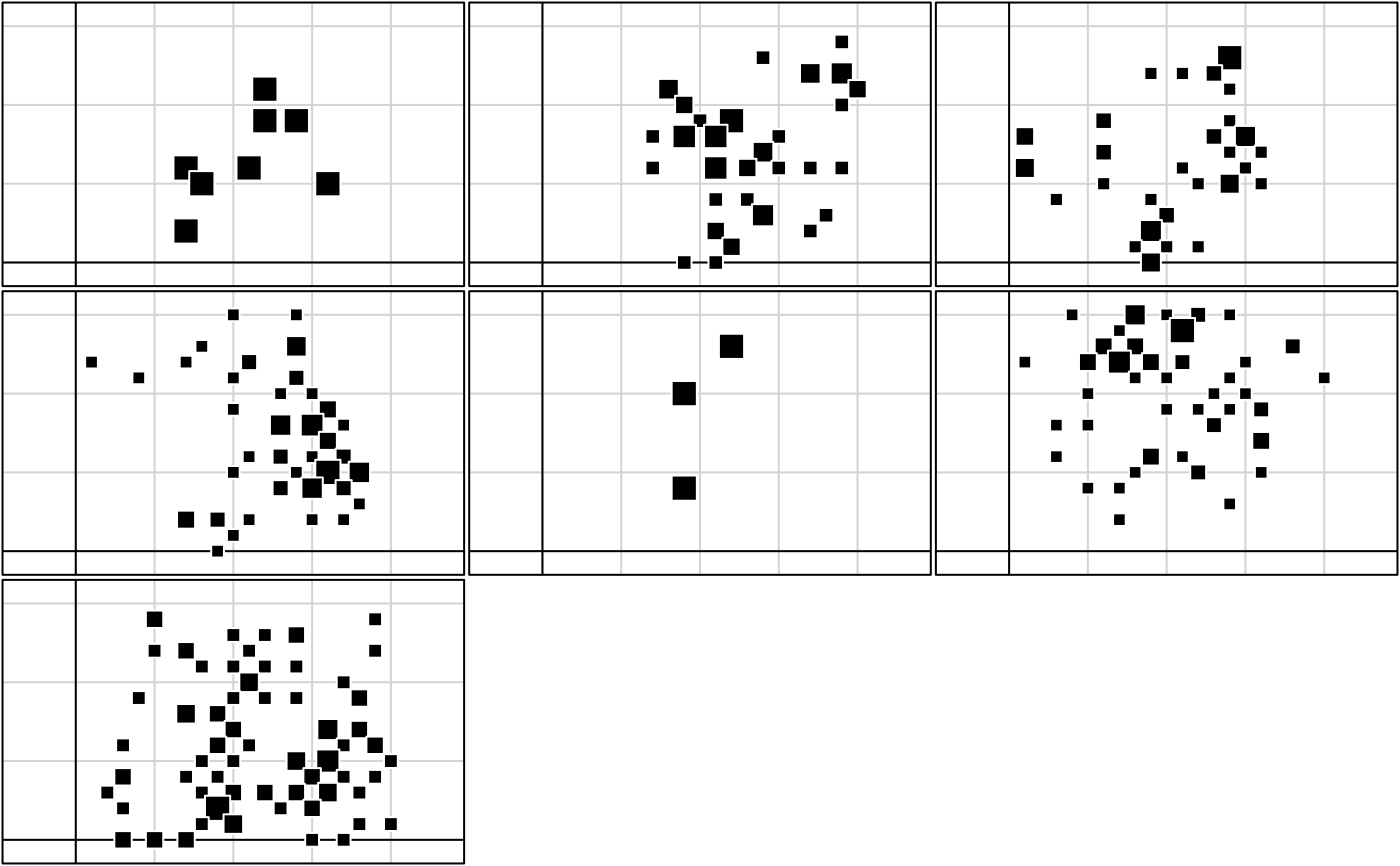Seed dispersal
julliot.RdThis data set gives the spatial distribution of seeds (quadrats counts) of seven species in the understorey of tropical rainforest.
Usage
data(julliot)Format
julliot is a list with the following components:
- tab
a data frame with 160 rows (quadrats) and 7 variables (species)
- xy
a data frame with the coordinates of the 160 quadrats (positioned by their centers)
- area
a data frame with 3 variables returning the boundary lines of each quadrat. The first variable is a factor. The levels of this one are the row.names of
tab. The second and third variables return the coordinates (x,y) of the points of the boundary line.- Spatial
an object of the class
SpatialPolygonsofsp, containing the map
Details
Species names of julliot$tab are:
Pouteria torta,
Minquartia guianensis,
Quiina obovata,
Chrysophyllum lucentifolium,
Parahancornia fasciculata,
Virola michelii,
and Pourouma spp.
References
Julliot, C. (1992). Utilisation des ressources alimentaires par le singe hurleur roux, Alouatta seniculus (Atelidae, Primates), en Guyane : impact de la dissémination des graines sur la régénération forestière. Thèse de troisième cycle, Université de Tours.
Julliot, C. (1997). Impact of seed dispersal by red howler monkeys Alouatta seniculus on the seedling population in the understorey of tropical rain forest. Journal of Ecology, 85, 431–440.
Examples
data(julliot)
if (FALSE) { # \dontrun{
if(adegraphicsLoaded()) {
if(requireNamespace("sp", quietly = TRUE)) {
obj1 <- sp::SpatialPolygonsDataFrame(Sr = julliot$Spatial, data = log(julliot$tab + 1))
g1 <- s.Spatial(obj1)
g2 <- s.value(julliot$xy, scalewt(log(julliot$tab + 1)), Sp = julliot$Spatial,
pSp.col = "white", pgrid.draw = FALSE)
}
} else {
if(requireNamespace("splancs", quietly = TRUE)) {
par(mfrow = c(3, 3))
for(k in 1:7)
area.plot(julliot$area, val = log(julliot$tab[, k] + 1),
sub = names(julliot$tab)[k], csub = 2.5)
par(mfrow = c(1, 1))
par(mfrow = c(3, 3))
for(k in 1:7) {
area.plot(julliot$area)
s.value(julliot$xy, scalewt(log(julliot$tab[, k] + 1)),
sub = names(julliot$tab)[k], csub = 2.5, add.p = TRUE)
}
par(mfrow = c(1, 1))
}
}} # }
if(adegraphicsLoaded()) {
if(requireNamespace("sp", quietly = TRUE)) {
g3 <- s.image(julliot$xy, log(julliot$tab + 1), span = 0.25)
}
g4 <- s.value(julliot$xy, log(julliot$tab + 1))
} else {
if(requireNamespace("splancs", quietly = TRUE)) {
par(mfrow = c(3, 3))
for(k in 1:7)
s.image(julliot$xy, log(julliot$tab[, k] + 1), kgrid = 3, span = 0.25,
sub = names(julliot$tab)[k], csub = 2.5)
par(mfrow = c(1, 1))
par(mfrow = c(3, 3))
for(k in 1:7)
s.value(julliot$xy, log(julliot$tab[, k] + 1),
sub = names(julliot$tab)[k], csub = 2.5)
par(mfrow = c(1, 1))
}
}

 if (FALSE) { # \dontrun{
if (requireNamespace("spdep", quietly = TRUE)) {
neig0 <- nb2neig(spdep::dnearneigh(as.matrix(julliot$xy), 1, 1.8))
if(adegraphicsLoaded()) {
g5 <- s.label(julliot$xy, nb = spdep::dnearneigh(as.matrix(julliot$xy), 1, 1.8))
} else {
par(mfrow = c(1, 1))
s.label(julliot$xy, neig = neig0, clab = 0.75, incl = FALSE,
addax = FALSE, grid = FALSE)
}
gearymoran(ade4:::neig.util.LtoG(neig0), log(julliot$tab + 1))
if (requireNamespace("adephylo", quietly = TRUE)) {
adephylo::orthogram(log(julliot$tab[, 3] + 1), ortho = scores.neig(neig0))
}
}} # }
if (FALSE) { # \dontrun{
if (requireNamespace("spdep", quietly = TRUE)) {
neig0 <- nb2neig(spdep::dnearneigh(as.matrix(julliot$xy), 1, 1.8))
if(adegraphicsLoaded()) {
g5 <- s.label(julliot$xy, nb = spdep::dnearneigh(as.matrix(julliot$xy), 1, 1.8))
} else {
par(mfrow = c(1, 1))
s.label(julliot$xy, neig = neig0, clab = 0.75, incl = FALSE,
addax = FALSE, grid = FALSE)
}
gearymoran(ade4:::neig.util.LtoG(neig0), log(julliot$tab + 1))
if (requireNamespace("adephylo", quietly = TRUE)) {
adephylo::orthogram(log(julliot$tab[, 3] + 1), ortho = scores.neig(neig0))
}
}} # }